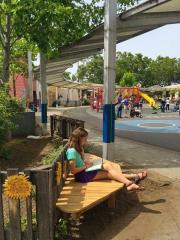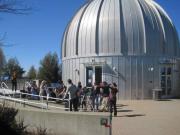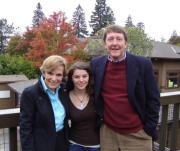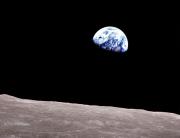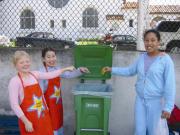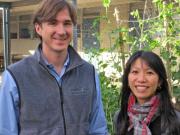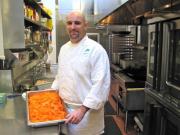Attuned to Nature
Attuned to Nature: My Reverence for the Environment
M y first memory of the natural world comes from a crisp, spring day when I, as a three year old, discovered the pussy willow buds bursting on long stems in the side yard of our home on Lincoln Street in a suburb of Chicago. Sometime later a front blew in and toppled a tall pole supporting a large vine. And in early summer while riding my tricycle in the neighborhood, I felt the vacuum blast of a tornado that ripped through the town, uprooting trees and sending my family into the basement for shelter. These were the first moments in my life’s journey becoming attuned to nature.
y first memory of the natural world comes from a crisp, spring day when I, as a three year old, discovered the pussy willow buds bursting on long stems in the side yard of our home on Lincoln Street in a suburb of Chicago. Sometime later a front blew in and toppled a tall pole supporting a large vine. And in early summer while riding my tricycle in the neighborhood, I felt the vacuum blast of a tornado that ripped through the town, uprooting trees and sending my family into the basement for shelter. These were the first moments in my life’s journey becoming attuned to nature.
How is it that we develop a love of nature? When and how do we discover that the environment is under great stress? And what can we do to redress the imbalance in our lives and restore the natural world? As a student of Harvard psychologist Howard Gardner, who developed the theory of multiple intelligences, I believe that all children are naturally “attuned to nature” and that as humans we are all “nature smart.” With educational experiences that were grounded in nature, I developed a love of the outdoors, and a conviction that we should promote environmental literacy in our schools. For me that belief developed over a lifetime of encounters with the natural world.
Attuned to Nature
The Illinois seasons in the 1950s and 60s were powerful educators. In a period known as the “Little Ice Age,” average temperatures dropped, snowfall was heavy, winter sports like sledding and skating abounded. Summers were full of nature’s bounty, as my family planted, nurtured, harvested a garden of vegetables that brought us fresh and wholesome food to eat. As a Cub Scout, I took field trips to walk the newly plowed fields in search of Native American arrowheads left from millennia of hunting in the now denuded forests; the sweet smell of the earth is still fragrant in my senses. As a child I learned about the cycles of the seasons, and the web of life that nature supported.
As a nineteen year old emerging from the self-focus of adolescence, I drove with my friend Ken on a voyage of discovery to the west coast in the summer of 1967. Heading west we made our way through the alluvial lands of the Mississippi River watershed, camped on the broad, silted flats of the Platte River, and reveled in the broad expanse of farmland covered in corn, wheat and soybeans. One afternoon while at the wheel, I peered into the distance at what appeared to be a fast approaching thunderstorm, only to discover the Rocky Mountains looming dark and brooding on the horizon. That first hike to Long’s Peak in Estes Park outside of Boulder filled my senses and awakened a love of the high mountains. Over the basin and range, past the Great Salt Lake, climbing the High Sierras past the Donner Party’s final resting place, and sweeping into the San Francisco Bay, I found my eyes opened to the natural beauty of America like never before.
That trip made me a Californian for life. After starting graduate school at Stanford, my mentor, history professor, advisor and friend, David Tyack, taught me one of the greatest lessons, my love of the High Sierras. Heading out in mid-October to camp on the Stanislaus River, we were caught in an early season snowstorm, spent bitter cold nights huddled in the car, and felt nature’s power.  Later that year, I headed on a late night excursion to Yosemite Valley, encountering the majesty of the three thousand foot vertical walls at midnight in mid summer. Backpacking in Yosemite and in the Desolation Wilderness brought me close to nature’s rhythms, cycles and flows. Years later, married to Helen and with our three kids, we made a quarterly pilgrimage to Yosemite to revel in the mystery of nature’s cathedral.
Later that year, I headed on a late night excursion to Yosemite Valley, encountering the majesty of the three thousand foot vertical walls at midnight in mid summer. Backpacking in Yosemite and in the Desolation Wilderness brought me close to nature’s rhythms, cycles and flows. Years later, married to Helen and with our three kids, we made a quarterly pilgrimage to Yosemite to revel in the mystery of nature’s cathedral.
For three years living in Portland, Oregon, my love of nature only deepened. The Pacific Northwest became a new tutor: vast pine forests, rain that gently nurtured abundant life, discovering wild rainbow trout while dry-fly fishing on the Deschutes River in Central Oregon.  One hot August afternoon in 1977 while visiting my in-laws, I decided to make my first solo climb of the magnificent Mt. Hood, and from the top it felt like I could see nature’s beauty forever.
One hot August afternoon in 1977 while visiting my in-laws, I decided to make my first solo climb of the magnificent Mt. Hood, and from the top it felt like I could see nature’s beauty forever.
Living in Northern California for thirty-five years, I came to realize how beautiful our natural treasures are in California. My wife and I made a point to travel with our children to some of nature’s most beautiful places—from Alaska to the Grand Canyon and from Yosemite to South Carolina’s barrier islands. Now, I hike the Berkeley hills in a huge park system that begins just blocks from my home, revel in the gentle fall colors of the West, and enjoy the subtle seasonal change. With a home in Inverness, we have learned about the “island in time” we inhabit, the rugged place that became the Golden Gate National Recreation Area and the Pt. Reyes National Seashore. Ancient seashores, tidal estuaries, shale reefs, a bird sanctuary with 450 species, the raptor flyway, and a Coho salmon spawning watershed that feeds into Tomales Bay all shape a land that calls to us.
Our Natural World Threatened
It did not take long for me as a young child to discover that our natural world was threatened, and over the years I have come to learn that we face a critical moment as human beings in our relationship to the planet. In the muggy heat of the Chicago summers, a battle was joined in the 1950s against the Dutch Elm disease that was killing hundreds of the tall arching trees that lined our streets in Hinsdale. Nightly, trucks plied the streets spewing clouds of chemicals, and as kids we took great delight in slicing through the fog on our bikes. The morning after one of these runs, I noticed that the yard was covered in Bluejays, gasping for air, slowing dying. It was several years later that Rachel Carson’s Silent Spring helped the villagers understand that they were poisoning their children, and themselves. About the same time while vacationing at our cottage on the southeast shore of Lake Michigan in the village of Saugatuck, out summer idle was tarnished when a new ocean-going tanker left our beaches covered with oil and tar. At the end of my years growing up in Illinois, I was home for Christmas in 1968 when Apollo 8 circled the moon on December 24th and sent back the first pictures of “earthrise” and gave us all a new perspective. We realized we were indeed living on spaceship earth, and the first Earth Day in 1970 signaled the birth of a whole new movement, but build awareness that we must respect the earth and learn to live sustainably.
Sadly, and at the very same time I first moved to California and fell in love with the West, I realized the environment was under siege. Hiking the hills above Stanford, I gazed in amazement at the sprawl that was covering the Bay wetlands, and while driving to the Sierra saw that we were paving the Central Valley’s paradise. Early in my years in Oregon, I learned that the delicious salmon I discovered were imperiled by a combination of dammed rivers, alluvial runoff, deforestation, and commercial fishing. The oil embargo of 1973, with the long lines and rapidly rising cost for gasoline, shocked our nation into understanding our dependence on fossil fuel. And by the time I became aware of our insatiable demand for lumber and the practice of clear-cutting the forests, only 5% of the native trees were left.
After my return to California in 1976, I was able to read the danger signs. A severe, three-year drought that began in 1977 later was shown to be part of a larger pattern as we discovered through tree-ring analysis that the twentieth century was the wettest in 1200 years in the West, and the law of averages almost assures that the future will be much drier. Water wars began to intensify, pitting farmers and city dwellers, Northern and Southern Californians, Americans and Mexicans against one another in a battle for scarce resources. The environmental shocks continued, with greater force and frequency: the 1979 oil embargo, the early 1980s drought, and the 1991 firestorm in the Oakland-Berkeley hills.  A family trip to Alaska in 1994 that I imagined would bring to life the rugged, snow-covered, chilly Artic climes from Jack London’s stories proved to be remarkably hot, with evidence all around of glaciers in rapid retreat and temperatures several degrees above recent averages.
A family trip to Alaska in 1994 that I imagined would bring to life the rugged, snow-covered, chilly Artic climes from Jack London’s stories proved to be remarkably hot, with evidence all around of glaciers in rapid retreat and temperatures several degrees above recent averages.
My family and friends teased me about my often-voiced comments that the climate was changing. Al Gore’s 1992 book, Earth in the Balance, provided the compelling evidence that this was true, and more importantly, that it was likely caused by human activity. The conclusion that he was likely right hit me like a kick to the gut. And his work impelled me to learn all I could about the subject in hopes of dealing with my dismay and finding a way to join the battle.
In the new century my studies led me to the conclusion that global climate change was real. The work of the UN Intergovernmental Panel on Climate Change (IPCC), a body of 2500 scientists from around the world provided increasingly definitive data that the parts per million of carbon in the atmosphere had risen from about 280 before the industrial revolution to nearly 390 today, and the work of Columbia University scientists James Hansen indicated that we needed policies to reduce the amount of fossil fuel consumption to bring that number down to a more sustainable level of 350. Elizabeth Kolbert’s Field Notes from A Catastrophe (2006) tells the story of shocking discoveries--Alaskan islands disappearing, Arctic sea ice going fast, Greenland glaciers melting, and CO2 emissions creating an acidic ocean and threatening the very web of life. Many other books--Al Gore’s An Inconvenient Truth (2006) and Our Choice (2009), Lester Brown’s Plan B (2009), David Orr’s (2009) Down to the Wire, Daniel Goleman’s Ecological Intelligence (2009)--made the case about climate change appear to be incontrovertible. While some may suggest that the scientific data in not definitive, scientists themselves point out that the nature of the discipline is not about final proof, but rather increasingly accurate measurements that point to the profound changes that are overwhelming our globe. As environmentalist Bill McKibben notes in his book Eaarth (2010), the only thing scientific models of climate change did not predict accurately is how fast our world is changing.
Hope and A Way Forward
After viewing the film “An Inconvenient Truth” with my wife Helen, I said on the walk home from the theater, “that was a profoundly depressing movie.” “Well,” she observed, “you could have that reaction, or you could do something about it. The last time I checked, you were a school principal, and you have a bully pulpit. Why don’t you use it?” That was exactly the kind of practical advice I needed.
In the years since, I have devoted my attention increasingly to the environmental movement in an effort to play my part as a citizen and address the accelerating impact of climate change.  In an article called “Greening the K-12 Curriculum,” Lisa Bennett tells a story about the dramatic, systemic changes we made at the Head-Royce School, the K-12 school of 800 students where I served as principal from 1984 to 2010. My partnership with the Center for Ecoliteracy and the Green Schools Alliance in Berkeley, the Realistic and Appropriate Energy Laboratory (RAEL) led by Dan Kammen at UC Berkeley, and the Alliance for Climate Education in Oakland, helped drive dramatic change that led to more efficient use of resources, a healthier environment on campus, an ecological curriculum, and a nutritional food program including a school garden.
In an article called “Greening the K-12 Curriculum,” Lisa Bennett tells a story about the dramatic, systemic changes we made at the Head-Royce School, the K-12 school of 800 students where I served as principal from 1984 to 2010. My partnership with the Center for Ecoliteracy and the Green Schools Alliance in Berkeley, the Realistic and Appropriate Energy Laboratory (RAEL) led by Dan Kammen at UC Berkeley, and the Alliance for Climate Education in Oakland, helped drive dramatic change that led to more efficient use of resources, a healthier environment on campus, an ecological curriculum, and a nutritional food program including a school garden.
The story of how we made Head-Royce a model green school is told in another article, “The Greening of Head-Royce School.” My experience there convinced me that were we to make similar changes at the nation’s 132,000 schools we would make a significant contribution to addressing the causes and consequences of climate change, now and into the future. That, indeed, had become my personal quest to make a difference.
Paul Chapman
November 2010
